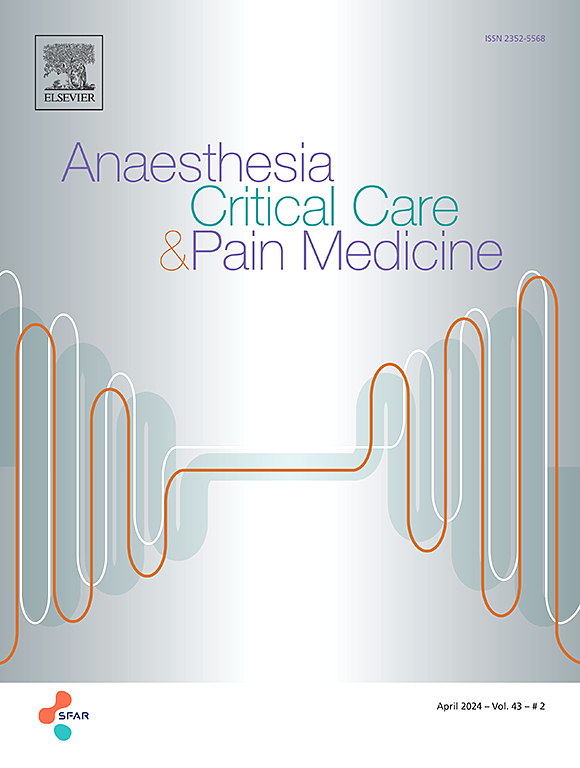Comparison of tolerance of 4 interfaces for preventive non invasive ventilation after abdominal surgery in intensive care units assessed by patients and caregivers: A prospective randomized cross-over study
IF 4.7
3区 医学
Q1 ANESTHESIOLOGY
引用次数: 0
Abstract
Introduction
Interface selection is one of the major determinants of success for noninvasive ventilation (NIV). The aim of this study was to compare the tolerance of 4 interfaces (auto and hetero-evaluation) used during preventive NIV in Intensive Care Units (ICU).
Methods
ICU patients receiving preventive NIV post-extubation after abdominal surgery were included in a prospective, single-center, randomized, crossover study. Four interfaces: two full-face (Helmet®, Bacou®) and two oro-nasal (Respironics®, Intersurgical®) interfaces were evaluated. An auto-evaluation (patients) and an hetero-evaluation (caregivers) were performed at the end of each NIV trial for each interface. Tolerance was evaluated with a visual numeric scale including: comfort (0 = maximum discomfort, 10 = perfect comfort), leaks (0 = maximum leaks, 10 = no leak), and communication (0 = no communication, 10 = optimal communication). A p-value <0.05/6 = 0.008 (Bonferroni correction) was considered significant.
Results
Twenty-six consecutive patients were included. For auto-evaluation of comfort and leaks, no significant difference was observed between the interfaces. For hetero-evaluation of comfort, significantly higher scores were observed for Helmet (9 (8–10)) compared to Respironics and Intersurgical (respectively 9 (7–9) p = 0.0073 and 8 (7–8) p = 0.0046), whereas no difference was observed for hetero-evaluation of leaks. Concerning the auto-evaluation of communication, higher scores were observed for Helmet (9 (6–10)), in comparison to the other interfaces (5 (3–7) p = 0.003, 5 (3–8) (p = 0.0017, 2 (0–5) p < 0.0001) for Bacou, Respironics and Intersurgical, respectively). Similar results were observed for hetero-evaluation. The caregivers overestimated comfort scores and communication scores for each interface (p < 0.008), except for Helmet (p = 0.05).
Conclusion
The results suggest that none of the interfaces is universally better than the others, with no differences in comfort scores. The choice of interface in NIV should be personalized, and the patient asked for the preferred interface. Auto-evaluation differed from hetero-evaluation.
由患者和护理人员评估的重症监护室腹部手术后预防性无创通气4种接口耐受性的比较:一项前瞻性随机交叉研究。
界面选择是无创通气(NIV)成功的主要决定因素之一。本研究的目的是比较重症监护病房(ICU)预防性NIV中使用的4种接口(自动和异质评估)的耐受性。方法:采用前瞻性、单中心、随机、交叉研究纳入腹部手术后接受预防性拔管的ICU患者。四个接口:两个全面接口(Helmet®,Bacou®)和两个口鼻接口(呼吸onics®,Intersurgical®)进行评估。在每个NIV试验结束时,对每个界面进行自动评估(患者)和异性评估(护理人员)。使用视觉数字量表评估容忍度,包括:舒适度(0 =最大不适,10 =完美舒适),泄漏(0 =最大泄漏,10 =无泄漏)和沟通(0 =无沟通,10 =最佳沟通)。p值结果:连续纳入26例患者。对于舒适性和泄漏的自动评估,在界面之间没有观察到显着差异。对于舒适度的异质性评价,头盔评分(9(8-10))明显高于呼吸器和Intersurgical评分(分别为9(7-9)p = 0.0073和8(7-8)p = 0.0046),而泄漏的异质性评价无差异。在沟通自动评价方面,头盔(9(6-10))的得分高于其他接口(5(3-7)p = 0.003, 5(3-8) (p = 0.0017, 2(0-5) p)。结论:结果表明,没有一个接口普遍优于其他接口,舒适度得分无差异。NIV的接口选择应个性化,患者要求首选的接口。自评价不同于异评价。
本文章由计算机程序翻译,如有差异,请以英文原文为准。
求助全文
约1分钟内获得全文
求助全文
来源期刊

Anaesthesia Critical Care & Pain Medicine
ANESTHESIOLOGY-
CiteScore
6.70
自引率
5.50%
发文量
150
审稿时长
18 days
期刊介绍:
Anaesthesia, Critical Care & Pain Medicine (formerly Annales Françaises d''Anesthésie et de Réanimation) publishes in English the highest quality original material, both scientific and clinical, on all aspects of anaesthesia, critical care & pain medicine.
 求助内容:
求助内容: 应助结果提醒方式:
应助结果提醒方式:


